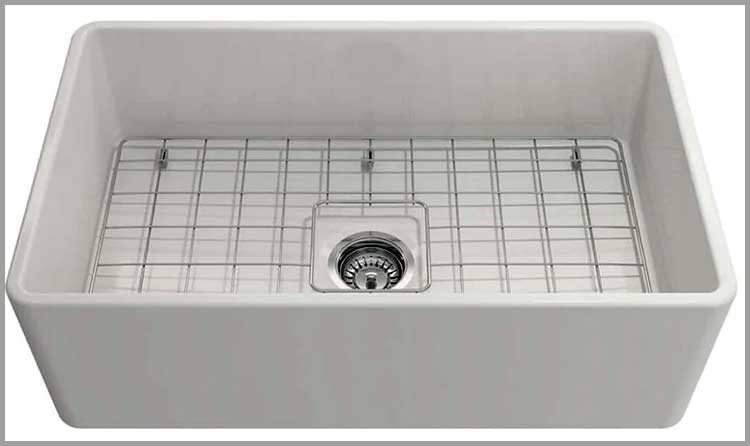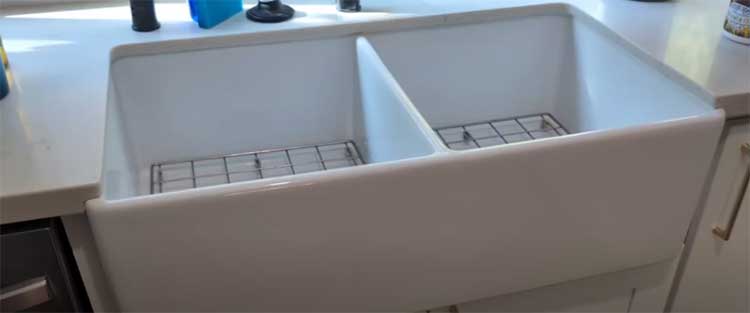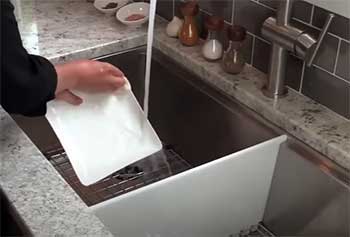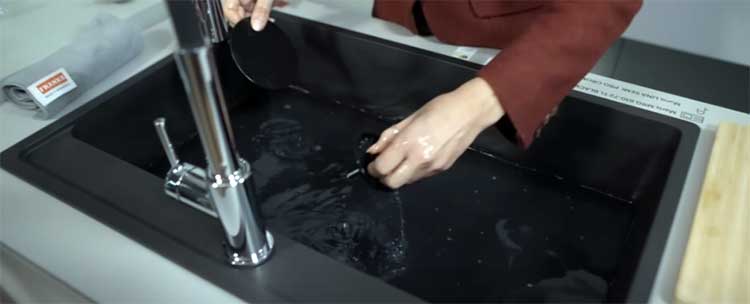I’m not one to throw around hype, but if you’re hunting for a kitchen sink that’s equal parts stylish, sturdy, and budget-friendly, Bocchi sinks are calling your name. Picture this: a gleaming fireclay beauty that transforms your kitchen into a showpiece without breaking the bank.
I’ve been through the sink-buying chaos myself, and trust me, Bocchi’s blend of quality, design, and value is tough to beat.
In this article, I’ll walk you through my experience, break down the pros and not-so-good parts, compare Bocchi to other brands, and share maintenance tips to keep your sink shining.
My Experience With The Bocchi Sink

When I decided to remodel my kitchen last year, I wanted a sink that could handle my chaotic cooking sessions while looking like it belonged in a magazine. After weeks of research, I landed on the Bocchi Classico 30-inch Apron Front Fireclay Sink in classic white.
Let me tell you, unboxing it felt like Christmas morning. The glossy finish caught the light in a way that made my countertop pop, and the solid heft of the fireclay screamed quality. It’s not just a sink; it’s the centerpiece of my kitchen.
Installing it was a bit of an adventure. At 70 pounds, this thing isn’t something you casually lift into place. I called in a pro to ensure the cabinet was reinforced properly, and I’m glad I did—fireclay sinks need that extra support.
Once it was in, though, it fit like a glove. The 30-inch size is perfect for my medium-sized kitchen, giving me plenty of room to soak pots or stack dishes during a big dinner party. The included bottom grid and strainer were a nice touch, protecting the basin and keeping things tidy.
I’ve been using it for over a year now, and it’s held up beautifully. From scrubbing burnt-on sauce off pans to rinsing piles of veggies, this sink takes everything I throw at it. The smooth, non-porous surface makes cleanup a breeze, and it still looks as shiny as day one.
Sure, I’ve had to be mindful about not dropping heavy cast-iron skillets, but that’s a small price to pay for a sink that’s this gorgeous and functional. Honestly, it’s made washing dishes—dare I say it—kind of enjoyable.
Why Bocchi Sinks Shine: The Pros

Let’s talk about why I’m so smitten with my Bocchi sink. It’s not just about looks (though it’s got those in spades). Here’s what makes Bocchi a standout choice.
- Unmatched Durability
Bocchi’s fireclay sinks are built like tanks. Made from organic, recyclable clay fired at a scorching 2000°F, these sinks are rock-hard. I’ve accidentally banged pots and pans against the basin, and there’s not a chip or scratch in sight.
The high-pressure casting process gives it a solid core that can handle heavy use without flinching. Plus, Bocchi backs this up with a limited lifetime warranty, so you’re covered if anything goes wrong. It’s peace of mind you don’t always get with other brands.
- Stunning Design Options
If you’re like me and want your kitchen to have personality, Bocchi’s got you covered. Their sinks come in nine colors—classic white, matte black, sapphire blue, you name it. I went with white for that timeless farmhouse vibe, but the matte brown or dark gray could add serious flair to a modern setup.
Whether you’re into sleek and contemporary or rustic and cozy, there’s a Bocchi sink that fits your style. The apron-front design of the Classico series is a showstopper, turning your sink into a focal point.
- Easy Maintenance with Clean+ Technology
I’m no fan of scrubbing for hours, so Bocchi’s Clean+ Technology is a game-changer. The glazed surface is non-porous and hydrophobic, meaning water and gunk slide right off. I’ve spilled red wine, dumped coffee grounds, and left tomato sauce splattered in there, and none of it sticks.
A quick wipe with a mild cleaner, and it’s back to sparkling. The included sink grid also protects the bottom from scratches and doubles as a drying rack, which is a lifesaver when I’m washing delicate glassware.
- Eco-Friendly and Food-Safe
As someone who cares about sustainability, I love that Bocchi uses 100% natural fireclay. It’s recyclable and produced with a reduced carbon footprint, so you’re doing the planet a favor. Plus, the non-porous surface is naturally antimicrobial, making it safe for food prep.
I’ve chopped veggies right on the sink’s edge (with a cutting board, of course) without worrying about bacteria lurking. It’s a small detail, but it makes a big difference in a busy kitchen.
- Great Value for the Price
Let’s be real—sinks can get pricey. But Bocchi delivers premium quality without the sticker shock. My Classico 30-inch sink cost around $500, which is a steal compared to brands like Kohler or Rohl that can run you $800-$2000 for similar features.
You’re getting a durable, stylish sink with accessories like a grid and strainer included, all at a price that won’t make your wallet cry. For budget-conscious folks who still want luxury, Bocchi’s a no-brainer.
The Not-So-Good Parts of Bocchi Sinks

No product is perfect, and Bocchi sinks have a few quirks you should know about. Here’s where they fall short, based on my experience and some digging around.
- Heavy as Heck
Fireclay is no lightweight material, and my Bocchi sink weighs a whopping 70 pounds. Installation was a hassle because I needed to reinforce my cabinet to support it. If you’re a DIYer, you might need a buddy or a pro to help lift and install it.
Undermount models like the Sotto can be even trickier, as they require precise cabinet cuts. If your kitchen setup isn’t ready for the weight, it’s a headache you’ll need to plan for.
- Limited Finish Luster
While Bocchi offers a ton of color options, the fireclay material makes glossy finishes harder to achieve. My white sink has a high-gloss shine, but some colors, like matte black or gray, lean more subdued.
If you’re dreaming of a super-shiny sink to match a sleek modern kitchen, you might find the matte options a bit underwhelming. It’s not a dealbreaker, but it’s worth considering if luster is a must for you.
- Risk of Cracks (If You’re Careless)
Fireclay is tough, but it’s not invincible. I’ve been careful with my sink, but I’ve read horror stories about cracks from dropping heavy pots or overtightening the drain flange.
One user on a home improvement forum mentioned their sink cracking after a hot pan hit it during a temperature swing. It’s rare, but it happens if you’re not mindful. You’ll need to treat it with a bit more care than a stainless steel sink.
- Not Ideal for Drop-In Installations
If you’re set on a drop-in or top-mount sink, Bocchi might not be your best bet. Their lineup focuses heavily on farmhouse and undermount styles, which require custom cabinet work. My apron-front sink needed a cabinet cutout, which added to the installation cost.
If your kitchen isn’t designed for this style, you’ll either need to modify it or look at other brands with more drop-in options.
Maintenance Tips To Keep Your Bocchi Sink Sparkling
Your Bocchi sink is an investment, and with a little TLC, it’ll stay gorgeous for years. Here’s how I keep mine in top shape, plus some tricks I’ve picked up along the way.
- Daily Cleaning Routine
I clean my sink every day to prevent buildup, and it takes less than a minute. Mix a splash of eco-friendly dish soap with warm water, grab a soft sponge, and give the basin a quick wipe.
For stubborn spots, I use a 1:1 mix of baking soda and vinegar—it’s like magic for cutting through grease or coffee stains. Avoid abrasive scrubbers like steel wool; they can scratch the glaze. Rinse thoroughly and dry with a microfiber cloth to prevent water spots, especially if you have hard water.
- Dealing with Hard Water Stains
Living in an area with hard water, I’ve had to tackle mineral deposits a few times. A citrus-based cleaner like CLR or a vinegar-soaked cloth left on the stain for 10 minutes does the trick.
I’ve also used a razor blade (carefully!) for stubborn buildup, but only after softening it with vinegar. Wipe the area dry afterward to keep that glossy shine. If you do this weekly, you’ll avoid the hassle of major buildup.
- Protecting the Surface
The included sink grid is your best friend. I keep mine in the basin at all times to protect against scratches from heavy pots or dropped dishes. If you’re washing delicate glassware, the grid cushions them, reducing breakage.
I also avoid leaving acidic foods like citrus or tomato sauce sitting in the sink for too long—they can dull the glaze if ignored. When in doubt, rinse promptly after use.
- Handling Chips or Scratches
Thankfully, I haven’t had to deal with chips, but if you get a small one, a fireclay repair kit from a brand like Franke can work. Mix the compound, apply it to the chip, and buff it smooth.
For scratches, a mild abrasive like Bar Keepers Friend can help, but use it sparingly to avoid dulling the glaze. If the damage is major, contact Bocchi’s warranty service—they’ve got a solid reputation for responsiveness.
- Avoiding Thermal Shock
Fireclay is heat-resistant, but sudden temperature changes can cause cracks. I learned this the hard way when I nearly poured boiling water into the sink right after rinsing with cold water.
Now, I let hot pots cool slightly before placing them in the sink, and I avoid extreme temperature swings. It’s a small habit that goes a long way in keeping your sink crack-free.
How Bocchi Stacks Up Against Other Brands?
Picking the right sink brand can feel overwhelming with so many options out there. I’ve compared my Bocchi Classico 30-inch fireclay sink to three heavy hitters—Rohl Farmhouse Sink, Create Good Sinks, and Franke Sink—based on my experience and research. Here’s how they stack up across key factors.
- Bocchi Vs. Rohl Farmhouse Sink: Style and Price

Rohl’s Shaws Original Fireclay Sink is the gold standard for luxury farmhouse sinks, with a handcrafted look that screams old-world charm. Its classic white finish and thick fireclay construction are stunning, but it comes at a steep cost—often $1500-$2000.
My Bocchi Classico, at around $500, delivers a similar farmhouse aesthetic with nine color options, including matte black and sapphire blue, giving it more modern flair. Rohl sticks to traditional white and biscuit, which limits versatility.
While Rohl’s craftsmanship is top-notch, Bocchi’s value and style variety make it a better pick for those who want luxury without the splurge.
- Bocchi Vs. Create Good Sinks: Durability and Features

Create Good Sinks, a newer player, offers fireclay farmhouse sinks with a focus on affordability, typically priced between $300-$600.
Their sinks are solid, but I’ve noticed they don’t feel as hefty as Bocchi’s, which is fired at 2000°F for extra strength.
Bocchi’s Clean+ Technology makes cleaning a breeze, and the included grid and strainer add practical value.
Create Good sinks often lack these extras, meaning you’ll spend more to get the same functionality.
If durability and bundled accessories matter to you, Bocchi edges out Create Good for a slightly higher price but better long-term reliability.
- Bocchi Vs. Franke Sink: Material and Maintenance

Franke’s Farm House Fireclay Sink is a direct competitor to Bocchi, with prices ranging from $600-$1200. Both brands use high-quality fireclay, but Franke’s CeramicPlus coating is slightly less slick than Bocchi’s Clean+ Technology, making Bocchi easier to clean when dealing with sticky messes like tomato sauce.
Franke offers fewer color options, mostly sticking to white and matte finishes, while Bocchi’s nine colors let you customize your kitchen’s vibe. Franke’s sinks are a bit lighter, which simplifies installation, but I prefer Bocchi’s thicker construction and antimicrobial surface for food prep.
- Bocchi Vs. The Competition: Installation and Versatility
Installation is where Bocchi’s weight becomes a factor. At 70 pounds, my Classico needed cabinet reinforcement, unlike Franke’s lighter models. Rohl’s sinks are similarly heavy, requiring similar prep, while Create Good’s lighter builds are easier for DIYers.
However, Bocchi’s focus on farmhouse and undermount styles limits its versatility compared to Franke, which offers drop-in options. Rohl and Create Good also lean heavily into farmhouse designs, but Bocchi’s broader color range and included accessories give it an edge for those prioritizing style and value over installation ease.
In the end, Bocchi holds its own against Rohl’s luxury, Create Good’s budget-friendly approach, and Franke’s versatility. It’s the sweet spot for style, durability, and affordability, especially if you’re after a farmhouse sink with modern touches.
Frequently Asked Questions (FAQ)
Absolutely, Bocchi is a fantastic choice for most kitchens. Their fireclay sinks are durable, stylish, and packed with features like Clean+ Technology and included accessories. They offer great value compared to pricier brands like Kohler or Rohl, with similar quality at a lower price point. My Classico sink has been a workhorse for over a year, and I’ve got no complaints. If you’re after a farmhouse or undermount sink that balances form and function, Bocchi’s hard to beat.
Fireclay sinks, like Bocchi’s, have a few drawbacks. They’re heavy, often requiring cabinet reinforcement and professional installation. They can crack if you drop heavy objects or subject them to extreme temperature changes. The material also limits glossy finish options, which might disappoint if you want a super-shiny look. Finally, they’re not ideal for drop-in installations, so you’ll need a compatible kitchen setup. With care, though, these issues are manageable.
It’s tough to crown one brand as the absolute best since it depends on your needs. Kohler is often considered top-tier for its wide range of materials and styles, but it’s pricey. Rohl and Shaws dominate in luxury fireclay, while Blanco and Bocchi offer great value. For me, Bocchi takes the edge for its affordability, design variety, and durability. If you’re looking for a fireclay farmhouse sink, Bocchi’s a strong contender for the top spot.
Bocchi sinks are designed in Italy but manufactured in Turkey. This combo keeps costs down while maintaining high-quality craftsmanship. The fireclay used is 100% natural and fired at 2000°F for durability. I’ve found the Turkish production doesn’t compromise quality—my sink’s finish and construction rival pricier brands made elsewhere.
Wrapping It Up: Why Bocchi Is Your Kitchen’s Best Friend?
If you’re ready to elevate your kitchen game, a Bocchi sink is the way to go. It’s durable, gorgeous, and won’t empty your wallet. From the moment I installed mine, it’s been a joy to use, making every dish-washing session feel a little less like a chore.
With easy maintenance and a range of styles, Bocchi delivers on all fronts. Trust me, you’ll wonder why you didn’t upgrade sooner. Go grab one and make your kitchen the envy of the neighborhood!
